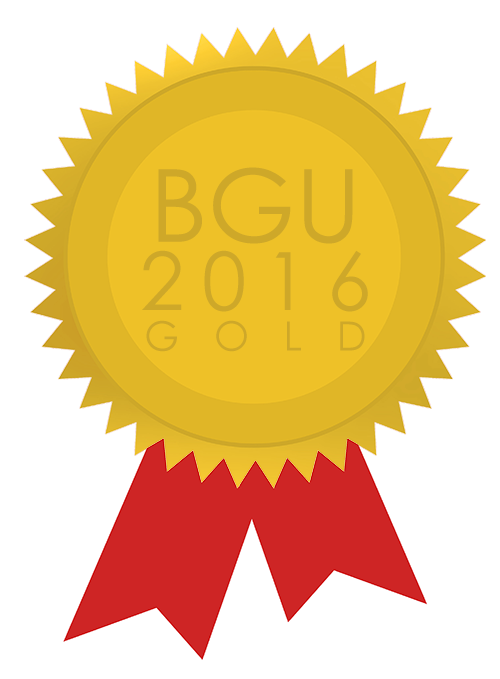| Line 154: | Line 154: | ||
<li> In our project, one of our aims was to <b>improve an existing PET degrading enzyme</b>. Since we worked on the <a href="https://2012.igem.org/Team:UC_Davis">UC-Davis 2012 LC-Cutinase gene</a>, we have managed to further characterize the previous wild type gene (<a href="http://partsregistry.org/wiki/index.php?title=Part:BBa_K936013">Part:BBa_K936013</a>) using kinetic activity tests and high-resolution identification. Furthermore, we registered new mutants for this gene who showed improved activity in comparison to the wild type enzyme. All the information can be found in our <a href="https://2016.igem.org/Team:BGU_ISRAEL/Results">Results</a> page, and the improved parts are: <a href="http://parts.igem.org/Part:BBa_K2091004">BBa_K2091004</a> and <a href="http://parts.igem.org/Part:BBa_K2091005">BBa_K2091005</a>.</li> | <li> In our project, one of our aims was to <b>improve an existing PET degrading enzyme</b>. Since we worked on the <a href="https://2012.igem.org/Team:UC_Davis">UC-Davis 2012 LC-Cutinase gene</a>, we have managed to further characterize the previous wild type gene (<a href="http://partsregistry.org/wiki/index.php?title=Part:BBa_K936013">Part:BBa_K936013</a>) using kinetic activity tests and high-resolution identification. Furthermore, we registered new mutants for this gene who showed improved activity in comparison to the wild type enzyme. All the information can be found in our <a href="https://2016.igem.org/Team:BGU_ISRAEL/Results">Results</a> page, and the improved parts are: <a href="http://parts.igem.org/Part:BBa_K2091004">BBa_K2091004</a> and <a href="http://parts.igem.org/Part:BBa_K2091005">BBa_K2091005</a>.</li> | ||
<li> Since our project consists of several different sub-projects, all designed to work together as a complete product, | <li> Since our project consists of several different sub-projects, all designed to work together as a complete product, | ||
| − | we showed several separate proofs of concept. For example, we have proven PET degradation by LC-Cutinase, | + | we showed several separate <b>proofs of concept</b>. For example, we have proven PET degradation by LC-Cutinase, |
and utilization of its products (specifically, ethylene glycole) by <i>E. coli</i> . i.e., we have shown that <i>E. coli</i> | and utilization of its products (specifically, ethylene glycole) by <i>E. coli</i> . i.e., we have shown that <i>E. coli</i> | ||
expressing LC-Cutinase can survive using PET as a sole carbon source. Moreover, we have constructed this experiment | expressing LC-Cutinase can survive using PET as a sole carbon source. Moreover, we have constructed this experiment | ||
Latest revision as of 15:32, 19 October 2016
Achievements
We want to thank the judges, students and all the people who took the time to read our wiki and learn about our project.
In our wiki we tried to show you what we learned, what we achieved, and how much fun we had doing it.
The medal criteria page is here to guide you through our project's highlights and major achievements.

Bronze Medal
- Our team was registered in March, and is excited see you in Boston!
- We have registered 8 new parts- BBa_K2091000 to BBa_K2091008
- We have submitted to the registry 2 new parts as of today (October 18, 2016)
-
Our Safety and judging Forms were submitted by the appropriate deadlines:
- About Our Lab
- About Our Project
- Final Safety Form
- Judging Form
- We have created an Attribution page to thank all the researchers, advisors and sponsors who helped us in our project. We could not have done it without them!

Silver Medal
- We have validated the work of all our LC-Cutinase's genes, (Registered parts BBa_K2091004 to BBa_K2091008) using several biological and chemical approaches. We discuss this characterization in our Experiments and Results pages.
- We have collaborated with several groups, national (Technion's S.tar group) and international (Korea Sonyeodul) in matters regarding the research part of our project. We also collaborated with several other groups, for example- XMU-China in various subjects, such as participating in newsletters and surveys, receiving information regarding plastic from other countries, etc. Here is our collaboration page.
- Every biological project raises questions regarding ethics and biosafety. As part of our human practices, we discussed matters of the ethics and safety of our project with several researchers and ethics experts. The information we learned, and the precautions we took to make sure our product would not cause harm to the environment and public, can be found in our Ethics & Safety and human practice pages.

Gold Medal
- Expanding our human practices, we tried to educate ourselves, and later, the public, about the plastic waste problem and its existing solutions. You can find all our meetings, events, publications and activities in our human practice page.
- In our project, one of our aims was to improve an existing PET degrading enzyme. Since we worked on the UC-Davis 2012 LC-Cutinase gene, we have managed to further characterize the previous wild type gene (Part:BBa_K936013) using kinetic activity tests and high-resolution identification. Furthermore, we registered new mutants for this gene who showed improved activity in comparison to the wild type enzyme. All the information can be found in our Results page, and the improved parts are: BBa_K2091004 and BBa_K2091005.
- Since our project consists of several different sub-projects, all designed to work together as a complete product, we showed several separate proofs of concept. For example, we have proven PET degradation by LC-Cutinase, and utilization of its products (specifically, ethylene glycole) by E. coli . i.e., we have shown that E. coli expressing LC-Cutinase can survive using PET as a sole carbon source. Moreover, we have constructed this experiment inside a dialysis have also seen PET degradation by E. coli . Since the PET degradation and the dialysis bag are essential in building our biofuel cell, we consider these achievements as proof-of-concepts towards our final goal. We have also shown biofilm creation of our chassis bacteria, P. putida, on an anode of a biological fuel cell, and managed to produce energy from the bacteria- that is a part of our final design. More info in our Results page.
- A big part our goals was to demonstrate our working product- a PET degrading biofuel cell. Our working method was to divide the system into small, attainable parts that we can demonstrate separately, before we build the final product. For example, we demonstrated a working biofuel cell with P. putida, and a working dialysis bag with E. coli. These tests prove that each of the parts can separately work in conditions similar to those existing in a working fuel cell. More info in our Results page.
In addition to the medal criteria, we also applied for several awards:


